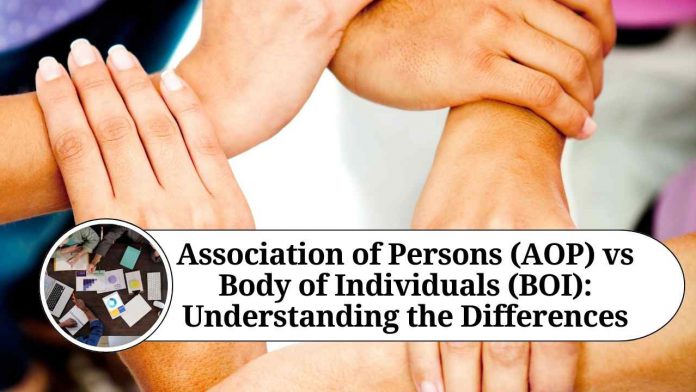In the world of taxation, two common terms that often confuse people are Association of Persons (AOP) and Body of Individuals (BOI). While both refer to groups of people coming together for a common purpose, they have distinct characteristics that set them apart. In this blog, we will explore the differences between AOP and BOI and understand their implications.
What is an Association of Persons (AOP)?
An Association of Persons (AOP) is a group of two or more people who come together for a common purpose, such as running a business or carrying out a specific project. According to the Income Tax Act of India, an AOP is not considered a legal entity, but rather a collection of individuals who jointly undertake an activity with a view to earning profits. In an AOP, each member shares the profits and losses of the activity in proportion to their respective contributions.
Examples of AOPs include partnerships, joint ventures, and cooperative societies. A partnership is a common type of AOP where two or more people come together to start a business and share the profits and losses. In a partnership, each partner is personally liable for the debts and obligations of the partnership.
What is a Body of Individuals (BOI)?
A Body of Individuals (BOI) is also a group of two or more people who come together for a common purpose, but unlike an AOP, a BOI is not formed with the intention of earning profits. BOI is a type of association where the members collectively own and manage a property or asset, and the income generated from that property is distributed among the members.
Examples of BOIs include clubs, housing societies, and charitable trusts. In a club, the members come together to enjoy certain facilities, such as sports facilities, and the income generated from the facilities is used to maintain them. In a housing society, the members collectively own the land and buildings and share the expenses and profits arising from them.
Differences between AOP and BOI
The primary difference between AOP and BOI lies in their purpose and nature of activity. An AOP is formed with the intention of earning profits, whereas a BOI is not. AOPs are commonly used for business ventures, while BOIs are used for the management of property or assets.
Another key difference is the way profits are shared. In an AOP, profits and losses are shared among the members in proportion to their contributions, while in a BOI, the income generated from the property or asset is distributed among the members.
AOPs are also subject to taxation differently than BOIs. In an AOP, the profits are taxed at the rate applicable to the individual members, while in a BOI, the income is taxed as an association of persons. This means that the tax rate for BOIs is higher than for AOPs.
In conclusion
While both Association of Persons (AOP) and Body of Individuals (BOI) refer to groups of people coming together for a common purpose, they have distinct characteristics that set them apart. AOPs are formed with the intention of earning profits and are subject to individual taxation, while BOIs are used for the management of property or assets and are taxed as an association of persons. Understanding these differences is important for anyone who wants to form or join a group for a specific purpose, as it will help determine the appropriate legal and taxation structures.
Other Related Blogs: Section 144B Income Tax Act
Frequently Asked Questions (FAQs)
Q: What is an Association of Persons (AOP)?
A: An Association of Persons (AOP) is a group of two or more people who come together for a common purpose, such as running a business or carrying out a specific project. AOPs are formed with the intention of earning profits and each member shares the profits and losses of the activity in proportion to their respective contributions.
Q: What is a Body of Individuals (BOI)?
A: A Body of Individuals (BOI) is a group of two or more people who come together for a common purpose, but unlike an AOP, a BOI is not formed with the intention of earning profits. BOIs are used for the management of property or assets, and the income generated from that property is distributed among the members.
Q: What are some examples of AOPs?
A: Examples of AOPs include partnerships, joint ventures, and cooperative societies.
Q: What are some examples of BOIs?
A: Examples of BOIs include clubs, housing societies, and charitable trusts.
Q: How are profits shared in an AOP?
A: In an AOP, profits and losses are shared among the members in proportion to their contributions.
Q: How is income distributed in a BOI?
A: In a BOI, the income generated from the property or asset is distributed among the members.
Q: How are AOPs and BOIs taxed differently?
A: In an AOP, the profits are taxed at the rate applicable to the individual members, while in a BOI, the income is taxed as an association of persons. This means that the tax rate for BOIs is higher than for AOPs.
Q: Which legal structure is better for a business venture, an AOP or a BOI?
A: An AOP is better suited for a business venture as it is formed with the intention of earning profits and the profits and losses are shared among the members in proportion to their contributions. BOIs, on the other hand, are better suited for the management of property or assets where the income generated is distributed among the members.




















